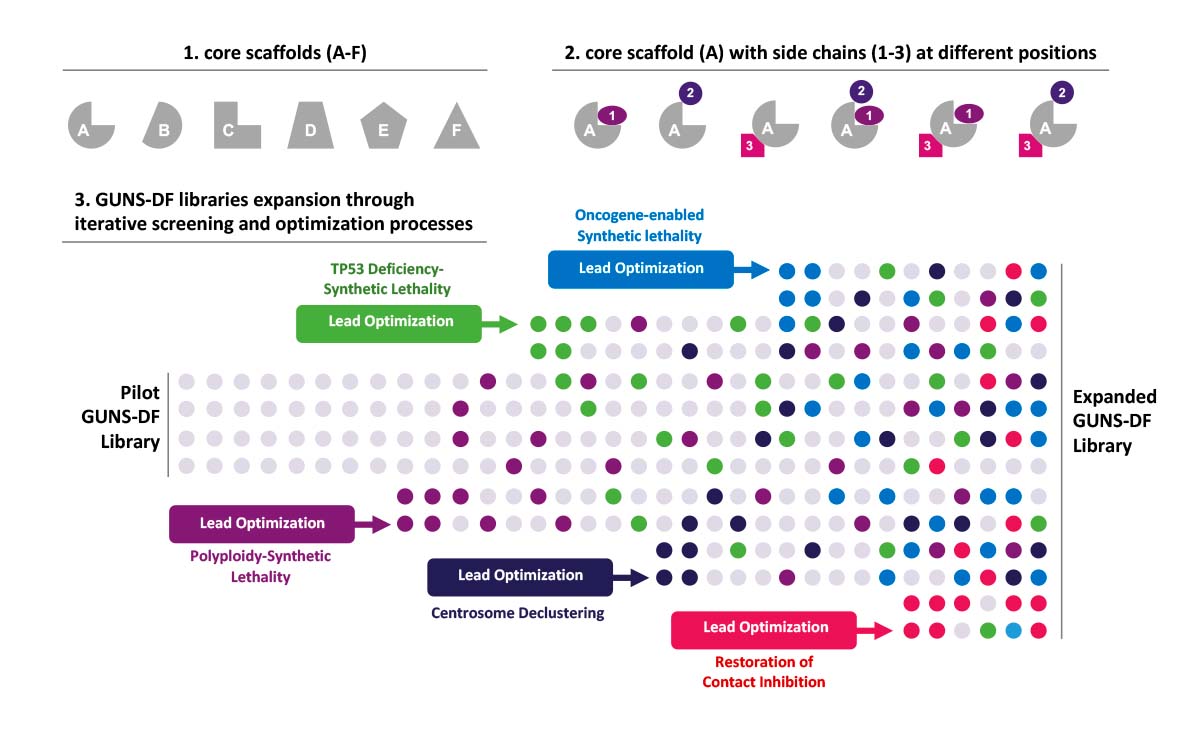Our diversified technology platforms can deliver novel innovative therapeutics that can be used alone or in combination with each other and clinically approved therapies.
As well as a bespoke chemical compound library, we have invested in developing one of the world’s largest natural product libraries, providing a rich screening resource for potential cancer therapeutics.
Target and biomarker discovery
Our drug discovery programs are driven by predictive biomarkers and begin with mechanism-informed and image-based screening in genetically defined cell lines to enable us to identify drug leads, drug targets, and predictive biomarkers. We focus on small molecule drugs that are orally available and have synthetic lethal interactions with a defined oncogenic alteration. Such a change together with the presence of a drug target in tumor cells can be used as predictive biomarkers to stratify patients for treatment. Patients negative for the biomarkers are not eligible for clinical trial enrolment.
Using a combination of isogenic model cell lines, MYC-driven mouse tumor cell lines and various human cancer cell lines, we conduct phenotypic screening for compounds that display selective lethality in cells with a defined oncogenic alteration such as overexpression of the MYC oncoprotein and loss of the tumor suppressor p53.

Small molecule library
Our proprietary small molecule library is constructed from drug-like scaffolds and has been designed for chemical diversity, especially in unexplored chemical spaces
- Constructed using principals of medicinal chemistry that anticipate potent inhibitors with enhanced drug-like properties.
- Well positioned to survey polypharmacology or chemicals with a more limited target specificity.
- Small sizes of our library scaffolds make it possible to use the same core scaffolds to inhibit different targets. For the same reason, it is also possible to find a compound that can inhibit multiple targets simultaneously. Small is beautiful. All of our library compounds are kinase hinge-binders.
- Produced a variety of active chemicals with distinct and/or overlapping target inhibition profiles.
- Suitable to screen for more potent chemicals targeting known cancer targets that will have novel scaffolds based on isosteres of chemical groups found in known drugs.
- GUNS-DF library was constructed by replacing core drug fragments with general unity new scaffolds. This library is specially designed to provide lead-like new chemical entities that have properties synergistic with other clinically used classes of small molecule drugs.

Natural Products library
Our Natural Products library offers natural compounds with structural diversity unavailable in synthetic combinatory libraries and compounds which have the potential to interfere with targets that are difficult to drug with synthetic compounds. These inhouse libraries are essential to discover anticancer drug leads, and are also valuable for the discovery of drugs to treat other diseases, which could be spun off as stand-alone business entities to serve academic and industrial researchers.
- Natural products (NP) are a prime source for new drugs due to their extensive diversity, broad chemical space, and complex chemotypes. Taking advantage of our strategic location in Sichuan, which houses over 60% of the plant diversity in China, we are building NP libraries that are compatible with high-throughput screening. These NP libraries include crude extract libraries of plants randomly collected in Southwest China, and pre-fraction libraries of Traditional Chinese Medicinal (TCM) herbs and plants that have been used to treat cancer long before the advent modern medicine. We have discovered and identified a variety of bioactivities from these NP libraries, validating their utility.
- To ensure the availability and reproducibility of raw materials, we are building our own plant diversity gardens and are expanding a network of collaborating partners to gain access to medicinal herbs cultured at a large scale. To increase the diversity of our library, we are collaborating with various national reserves to study and preserve rare plants and plants in danger.
- We have 17636 crude extracts, 1211 partally purified fractions and 2452 pure natural compounds from plants used in Tradtional Chinese Medicine.
